Journal of Water Resource and Protection
Vol.5 No.2(2013), Article ID:28279,8 pages DOI:10.4236/jwarp.2013.52021
Complementing Water Supply through Rainwater Harvesting in Some Selected Villages of Sahel Savannah Ecological Zone in Borno State Northeastern Nigeria
Department of Urban and Regional Planning Modibbo Adama, University of Technology, Yola, Nigeria
Email: htishaku123@gmail.com
Received September 26, 2012; revised November 6, 2012; accepted December 8, 2012
Keywords: Rainwater Harvesting; Water Supply; Sahel Savannah Ecological Zone
ABSTRACT
One of the greatest environmental challenges that confront rural communities in Nigeria especially in Borno state is scarcity of water supply. Rainwater harvesting can reduce over dependence on centralized piped water supply and checkmate climate change. This study in two rural communities determined the water per capita use, examined water sources and then estimated the amount of rainwater that can be harvested by households in these villages. The villages are Kukurpu and Yelwa Bam in Hawul local government area of Borno state Nigeria. The choice of the villages is justified on the basis of their location in the semi-arid region of the Sahel ecological zone with lesser rainfall compared to other parts in the region. Lack of adequate access to water supply is precursor to water related diseases and challenge to sustainable development. This study used scheduled interview with households and 100 household were surveyed using simple random sampling. In each of the village, 50 observations were made Results revealed that 87% of the households rely water from hand dug wells, ephemeral streams and boreholes equipped with manual hand pumps that are susceptible to drought and frequent breakdown. Borno state where the villages are located had a mean annual rainfall of 860 mm from 1980 to 2009; however, the annual rainwater harvesting potential was put at 51.21 m3. Although over 80% are aware of rainwater harvesting practices only 2% of households harvest rainwater due to the seasonality of rainfall coupled with inadequate water storage facilities. There is therefore the need to embark on massive rainwater harvesting with corresponding water reservoir as a way to reduce the effects of the five months dry spell experienced in the region.
1. Introduction
Water is one of the most important natural resources on the surface of the earth therefore its importance cannot be overemphasized. It can be used for drinking and other domestic purposes. Water covers a substantial part of the earth surface, fills the oceans, rivers and lakes. It is found under the ground and in the air. These facts notwithstanding, it is interesting to note that there is hardly enough water to drink and meet other basic requirements such as cooking, washing, bathing among other usage in most rural communities of developing nations. [1] revealed that only 0.6% of water is available for human uses as fresh water in rivers, streams, springs and aquifers. The remaining 96.5% are in oceans, seas and bays while 1.74% as ice, glaciers and permanent snow and 1.16% are from other sources of water supply. Most rural communities are spread over a wide area, thus increasing the cost of providing piped water networks.
The [2] defined access to water as the number of people who have reasonable means of obtaining sufficient amount of water that is safe for drinking, cooking, washing and other important household activities expressed as a percentage of the entire population. Access to safe water is universal need and, in fact a very important requirements. Accessibility to water is critical to the development of human beings and vital strategy for poverty reduction and includes a very important aspect of basic primary health care services. Inadequate safe water supply manifest in so many ways such as infant mortality, increased health care services, public servants productivity, decrease in school enrolment among others [3]. Lack of access to potable water has been a thing of great global concern. In Nigeria, only 47% have access to improved sources [4] Africa, despite having lower population than Asia, accounts for one-third of global population without access to improved water supply and has the lowest service coverage figures of any continent (Harvey and Reed, 2004). This can be attributed to a number of factors such as increasing population leading to higher demand for fresh water for domestic, industrial, agricultural and landscape management purposes. Above all, climate changes have negatively affected water supplies.
[5] reported that 20 - 50 liters of safe water on daily basis is required by individual for basic human domestic needs. This implies five liters for drinking, 20 liters for sanitation services, while 15 liters is for bathing and 10 liters for preparation of food. However, [3] stipulates that 20 liters of potable water is needed by each individual for drinking, cleaning and cooking and other domestic needs. Water use and pattern of use differs from one place to the other and for various purposes such as drinking, washing, cleaning and the manufacturing of goods, crop production among other uses [6]. The water required for the various activities vary from place to place and more specifically lifestyle, tradition, culture, prevailing climatic conditions, wealth and technology in use.
The vital role of sufficient quantity of water supply for human well-being has been recognised for a very long time. There have been heated arguments on the significant importance of the quantity of water required by individual [7-9]. Aside from this argument, there has not been universal yardstick for minimum quantities that water agency or water board should provide. While the target 10 of the Millennium Development Goals is to reduce by 50 percent the population of persons that do not have access to safe drinking water by 2015 [10] it did not state the quantity of water to be provided. The [11] stated that sufficient access safe water is the ability of individual to obtain at least 20 l/p/d from a water source in close proximity of less than one kilometer to household’s residence. However, it is worthy of note that this prescription signifies primarily to access and not a yardstick that 20 l/p/d is a universal acceptable standard for water supply. The water use varies from one place to the other depending on which activity pattern of water usage.
Adequate safe water supply implies that the time spent by women and children in trotting water can be used for other productive works that will improve the living standard of the households. Many people in rural communities who do not have access to improved water supply are susceptible to water related diseases such as bilharzias, cholera and hookworm [12]. Improvement in water supply service delivery will eventually result in the improvement in the living standard of the rural people. Access to improved adequate safe water supply will lead to reduction of human suffering; increased productive capacities that at the end will reduce health care cost [13]. This can only be realized if water is set in the broader context of health objectives.
It was predicted by the [4] that water scarcity will be one of the most important issues in the 21st century. The implication is that the 21st century has opened up with one of the most fundamental conditions of human development unmet, which is universal access to basic water service. The failure of international aid community of nations and local organizations to satisfy the basic human needs has led to substantial, unnecessary and preventable human suffering. Reports from development agencies, government, water commissions and research institutes continually points to an impending water crisis [14].
Nigeria has adequate surface and ground water resources to meet current demands for potable water supply though temporal and spatial distribution of water resources has led to scarcity in some locations especially in the north [15]. This disparity has increased rapid depletion of groundwater, especially in the northern towns and villages which have resorted to other available sources. There are 774 local government councils in Nigeria which are responsible for the provision of rural water supplies facilities in their areas. Out of these number only a few have the resources and skills to address the water problem. The few local government areas that have rural water supply divisions are able to construct small water systems such as open wells and small impoundments of surface water.
2. Why Rainwater Harvesting?
Rainwater harvesting is a technology used in collecting, conveying and storing rainwater from relatively clean surfaces such as a roof, land surface or rock catchments for later use [16,17]. Rainwater harvesting is an option which has been adopted in many areas of the world where the conventional water supply systems have failed to meet the needs of the people. In many cases rainwater harvesting has been introduced as part of an integrated water supply system where the town supply is unreliable or where local water sources dry up for a part of the year. Rainwater harvesting reduces the amount of money spent on water consumption and at the same time save natural resources and over dependence on ground surface water supply [18,19]. This water that would otherwise have gone down the drainage system, into ground or been lost to atmosphere through evaporation the water can be collected and stored in a rainwater tank or directed into mechanisms that can recharge ground water. Rainwater harvesting can provide water for human consumption at the points of need, reduce water bill and lessen the need to build reservoirs which may require the use of valuable land therefore reducing environmental caused by surface runoff [20,21]. Rainwater harvesting is a technology that is flexible and adaptable to a wide variety of conditions being used in the richest and poorest societies on earth and the wettest and driest regions of the world. For this noble objective to be achieved the communities must be actively involved in their water supply process right from the onset of any water project they deem fit.
3. Material and Methods
3.1. Study Area
Borno state has a total with land mass of 69,435 sq∙km lies between latitude 10˚N to 13˚N and longitude 12˚E to 15˚E. The greater part of the state lies on the Chad basin. It is bounded to the west by Yobe state, to the north by Niger and Chad republics and to the East by Cameroon republic while the southern part is bounded by Adamawa and Gombe states [22]. The topography of Borno state especially towards the Cameroon boarder show as high as 2040 m above sea level [23]. Borno state is located in the Sahel Savannah ecological zone. Figure 1 the map of Nigeria showing Borno state with Kukurpu and Yelwa Bam villages.
The two villages studied relied on ground water sources from hand dug well, ephemeral stream and seasonal rainfall for their domestic uses. Based on the survey results ground water can be accessed through hand dug wells and borehole equipped with manual pumps. The villages featured same type ground water availability. According to [22] the village of Kukurpu and Yelwa Bam with an estimated population of 947 and 632 people respectively have limited access to underground water supply during the rainy season but during the dry seasons, these sources dry up forcing households to trek longer distances in search for water. In some cases cattle rearers
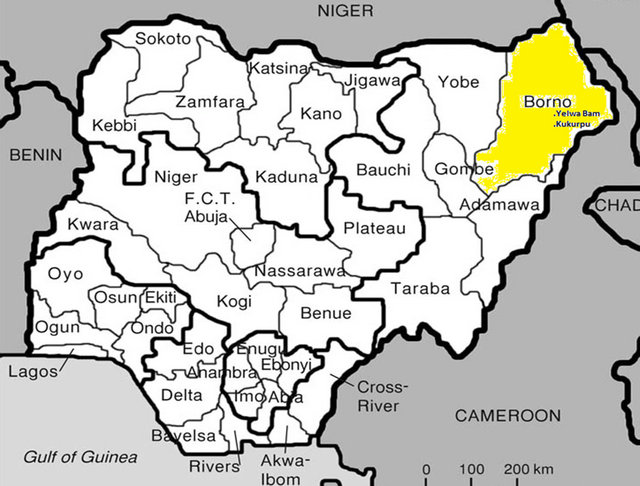
Figure 1. Map of Nigeria showing Sahel Savannah ecological zone (http://www.nairaland.com/Nigeria/topic-148185.html).
from the Sahel region have to migrate to the Guinea Savannah with lush pasture to feed their animals.
The people of these villages are engaged in subsistence agriculture and animal husbandry. The ephemeral streams provide these villagers with fertile land for the production of vegetables. Within the streams floodable plain vegetables are grown especially during dry season through irrigation agriculture mostly done by the women to complement their household income. They make use of water pumping machines to irrigate their plots but during the rainy season the stream normally overflows its banks rendering the area water logged and cannot be used until after the end of the wet season. Figures 2 and 3 below shows the spatial pattern of Kukurpu and Yelwa Bam village.
3.2. Method
Data were generated through a combination of primary and secondary sources. The households provided valuable information on their water use, distance to nearest
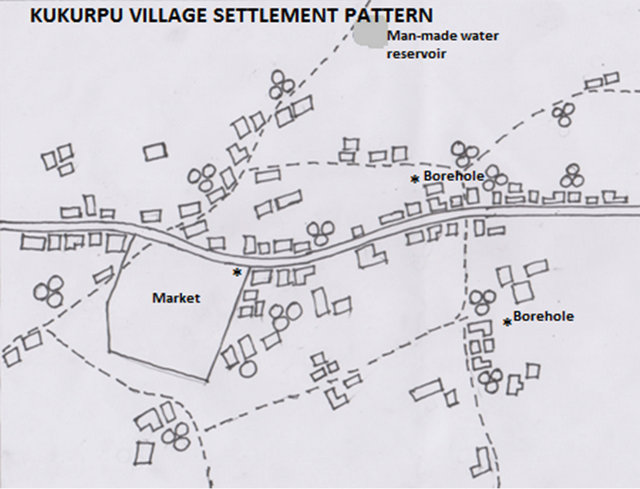
Figure 2. Spatial settlement pattern Kukurpu village.
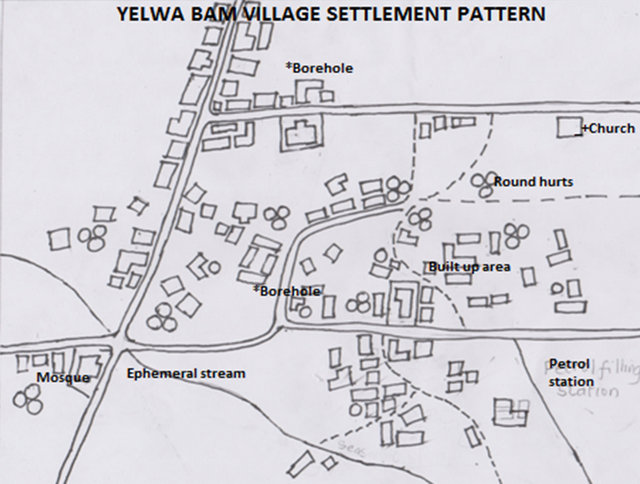
Figure 3. Spatial settlement pattern Yelwa Bam village.
water sources, and effects of lack of access to water supply among others. The principal researcher spent one week in each village observing the water use as well as conduct formal and informal interviews with heads of households. The formal interview instrument developed a structured questionnaire with multi-choice answers and was administered to 100 heads of households in the two villages. The secondary data on rainfall for the period of 30 years beginning from 1980 to 2009 was obtained from the Nigerian meteorological agency (NIMET) in Abuja.
4. Results and Discussion
4.1. Profile of Respondents
Survey responses revealed that 64% of respondents are male while 36% are female head of households. In terms of their occupation, results shows that cattle rearing accounts for 59% this was followed by farming 17% and petty trading 16% and government employee account for only 8%. On the average 76% of the households earn more than N10,000 monthly ($62.00). This is below the Federal government prescribed minimum wage for its work force. However, about 56% of households have one form of formal education or the other while 44% did not attend formal education. The household sizes for the two villages range from 1 - 5 were put at 75% while those above six account for 25%.
4.2. Sources of Water Supply and Distances Covered
Majority of households in the two villages rely on water from well 60%, borehole 11% and ephemeral stream 27% while household harvest rainwater 2% for domestic use. Responses on the negative effects of lack of access to water supply revealed that health related cases account for 50%, delays in doing household chores 32% while higher expenditure was 18%. Results revealed that over 63% of households use more than 30 liters of water for their daily needs. This agrees with the [2,3,5] stipulated water requirements for daily needs. On the distances covered to nearest water sources, it was reported that about 60% of household walk distances more than 2 km to trot water and 16% walk less than 1 km while 25% walk for 2 km to get water especially during the dry seasons. Water storage facilities are one of the greatest factors militating against low patronage in rainwater harvesting. Survey responses revealed that majority of households 41% store their water in drums of 100 liters capacity, 32% in pot, 18% in Jerry can and 9% in bucket that last only for few days.
4.3. Rainwater Harvesting Awareness
Although 85% of respondents are aware of rainwater harvesting technology only 2% harvest and use rainwater. Thus, rainwater harvesting method is through rooftop 91% ground surface runoffs 8% and underground water harvesting 1%. The harvested water is mostly used for drinking 69%, irrigation 16% watering animals 8% and washing 7%. Despite the fact the fact they are aware of rainwater harvesting only 2% of rainwater is actually collected due to lack of adequate water storage facilities that will last for several months and the seasonality of rainfall in the region.
4.4. Water per Capita Use
During rainy season water use in Kukurpu and Yelwa Bam villages their water use was found to be 40 l/p/d this notwithstanding; during the dry season average water use could be as low as 12.5 l/p/d. Figure 4 reveals the results of the assessment of domestic water use by activity the two villages. As can be noticed from the figure the responses on household domestic water use by activity in the two villages revealed that water for bathing was ranked the highest as 20 l/p/d is used for that activity. Due to availability of water during the rainy season households uses more water for bathing. However, in the dry season because of water shortages, water used for bathing dropped to 10 l/p/d. This was closely followed by water for washing clothes and dishes which account for 18 l/p/d. Water use for cooking during the two seasons remain 10 l/p/d and water use for drinking is 5 l/p/d during dry season and 2 l/p/d during the rainy season.
The reason for increase in drinking water is that during the dry season households are busy preparing their farmland for the farming season. During this period humidity is low and demands for drinking water are higher. Domestic water use in this study refers to both surface and ground water collected and brought to household for use. The most significant difference in water use is water used for bathing while water used for washing clothes and dishes was ranked second in terms of quantity. The activity patterns considered include water use for drinking, bathing, food preparation and washing (clothes and dishes). Focus group discussion with households in the two communities revealed that water provision for domestic use is the primary responsibility of the female member household members. The men however, are responsible for rearing cattle in the bush.
4.5. Potential for Rainwater Harvesting in the Villages
To effectively carry out rainwater harvesting in the two villages studied, it was necessary to determine the availability of rainfall since it is the key climatic variable. The two villages are located in Sahel Savannah region of the northeastern Nigeria of the study area have been receiv-

Figure 4. Domestic water use by activity in Kukurpu and Yelwa Bam.
ing a reasonable amount of rainfall for the past three decades. Thus, Kukurpu and Yelwa Bam villages located in Borno state of the Sahel Savannah ecological zone recorded 860 mm from 1980 to 2009. This amount of rainfall is enough to guarantee rainwater harvesting. To determine rainfall availability, secondary data on rainfall for Borno state was obtained from The Nigerian Meteorological Agency Abuja (NIMET). The rainfall records obtained carry a 30 years monthly rainfall data (1980- 2009). The rainfall data were first analyzed to determine the characteristics of the rainfall in terms of rainfall pattern, average monthly rainfall, average annual, and wet and dry months for the years under consideration. The intra annual variability of rainfall was determined by solving for the coefficient of variation of the monthly rainfall while inter annual variability of the rainfall was determined using annual cumulative rainfall. The coefficient of variation is thus expressed as:
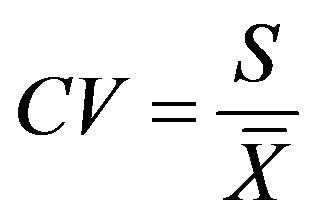
where CV: coefficient of variation of the monthly rainfall or the annual cumulative rainfall;
S: standard deviation of the monthly or annual rainfall (in mm);
 : mean of the monthly or annual rainfall (in mm).
: mean of the monthly or annual rainfall (in mm).
Rainwater harvesting can be undertaken through surface or rooftop runoff. This study, however, focused only on rooftop rainwater harvesting given that it is a cleaner alternative. Thus, the amount of rainwater that can be harvested depends on roof area, rainfall intensity, storage and runoff coefficient which depend on roof material and design [24]. The equation used by [25] is adopted in this study to calculate the amount of rainwater that can be harvested per household per month. The equation is given thus:
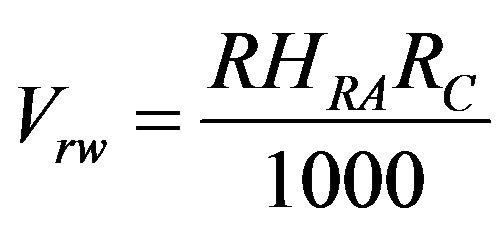
where VR: monthly volume of rainwater per household (m3);
R: monthly rainfall (mm);
HRA: household roof area (m2);
RC: runoff coefficient (dimensionless).
The monthly rainfall data were taken as average monthly rainfall from 1980-2009 and the household roof area per dwelling was estimated during field observation to be around 70 m2. The value for runoff coefficient is taken to be 0.85 for hard roof in humid tropics, the value used by [26], based on [24]. Figure 5 also shows the low variability of annual rainfall distributions over the years with the coefficient of variation calculated 0.10 for Borno. The situation is different for monthly rainfalls because there is a distinct bimodal rainfall pattern within a year. This high variability in monthly rainfall is supported by the fact that the coefficient of variation of monthly rainfall ranges from 0.16 to 5.28, 0.01 to 4.27 for Borno State [27].
If water year is taken to begin from March, there is a distinct dry season that last for five months from January to March and November and December in the Sahel Savannah ecological zone. The wettest months for Borno state are July to September when the rainfalls average is above 200 mm per month before dropping noticeably in October and then completely dry thereafter until end of February. Ensuring sustainable yearly supply of rainwater from this pattern of rainfall distribution requires proper planning for harvesting and storage of the excess water. Results of the analysis of rainfall data revealed that average annual rainfall received in Borno state was 71.72 mm.
4.6. Monthly Rainwater to Be Harvested by Households
As previously highlighted, actual water sources for the area however currently comes from various sources and rainwater is only a small part of it. Even though rainwater can be practically harvested from May to October, ample excess of rainwater for storage for the coming months are only available from July to September for Borno states. Annual RWH potential per household was 51.21 m3 for Borno state. The amount cannot meet the water demand for of Kukurpu and Yelwa Bam having a
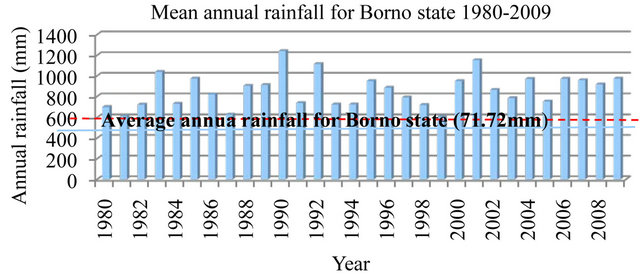
Figure 5. Mean annual rainfall for Borno state from 1980 to 2009.

Figure 6. Mean monthly rainfall depth for Borno from 1980 to 2009.
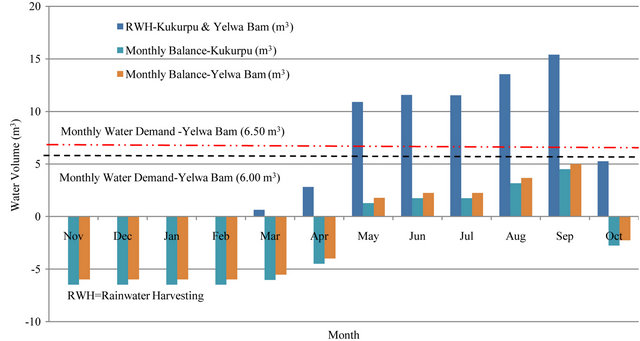
Figure 7. Household monthly harvested rainwater and monthly balance for Kukurpu and Yelwa Bam.
Table 1. Household monthly harvested rainwater and monthly balance for Kukurpu and Yelwa Bam.

deficit of 26.79 m3 Thus, other sources as discussed before are still needed to a certain extent to compliment household’s water demands. Figure 7 shows household monthly harvested rainwater and monthly balance for Kukurpu and Yelwa Bam. While Table 1 shows household monthly harvested rainwater and monthly balance for Kukurpu and Yelwa Bam village.
5. Conclusion
Despite the fact Borno state is located in the drier north of the Sahel Savannah, it has been recording annual rainfall of 860 mm for the past 30 years which is enough to guaranty rainwater harvesting to carter for the five month dry spell in area and households harvest only 2% of the water consumed in the villages. This is due to the seasonality of rainfall coupled with water storage facilities that include clay pot, bucket, Jerry can and drums that are under sized which cannot last for longer periods. It is recommended that households need to embark of massive rainwater harvesting to be stored in underground reservoir for later use.
REFERENCES
- I. Shiklomanov, “Water in Crisis: A Guide to World’s Fresh Water Resources,” In: P. H. Gleick, Ed., Oxford University Press, New York, 1993. http://www.google.com.my/imgres?imgurl http://gov/watercycle.jpg&imgrefurl http://water.usgs.bov/watercyclele hi.html&1
- UN, “Comprehensive Assessment of the Freshwater Resources of the World,” Commission on Sustainable Development, New York, 1997.
- World Bank, “Sector Report on Water Resources Strategy Paper on Effective Management of Water Resource in Africa,” World Bank, Washington DC, 2002.
- World Bank, “Sector Report on Water Resources Strategy Paper on Effective Management of Water Resource in Africa,” Effective Management of Water Resource in Africa, Washington DC, 2000.
- P. H. Gleick, “Basic Water Requirements for Human Activities: Meeting the Basic Needs,” Water International, Vol. 21, No. 2, 1998, pp. 83-92. doi:10.1080/02508069608686494
- G. F. White, D. J. Bradley and A. U. White, “Drawers of Water, Domestic use in East Africa,” University of Chicago Press, Chicago, 1972.
- A. M. Cairncross, “Health Impacts in Developing Countries: New Evidence and New Prospects,” Journal of the Institution of Water and Environmental Management, Vol. 4, No. 6, 1990, pp. 572-577.
- S. A. Eserey, R. G. Feachem and J. M. Hughes, “Interventions for the Control of Diarrhoeal Diseases among Young Children: Improving Water Supplies and Excreta Disposal Facilities,” Bulletin of the World Health Organization, Vol. 63, No. 4, 1985, pp. 757-772.
- S. A. Eserey, J. B. Potash, L. Roberts and C. Shiff, “Effects of Improved Water Supply and Sanitation on Ascariasis, Diarrheoea, Dracunliasis, Hookworm Infection, Schitomiasis, and Trachoma,” Bulletin of World Health Organization, Vol. 69, No. 5, 1991, pp. 609-621.
- UN, “In Larger Freedom: Towards Development, Security and Human Rights for All,” United Nations, Geneva, 2000.
- WHO/UNICEF, “Joint Monitoring Progress on Drinking Water and Sanitation a MDG Assessment Report,” World Health Organization, Geneva, 2008.
- WHO, “Global Water Supply and Sanitation Assessment,” Joint Monitoring Program for Water Supply and Sanitation, World Health Organization, New York, 2000.
- C. Shaw, “Tri-Sector Partnerships: How They Work?” Department for International Development Magazine, Vol. 2, No. 18, 2003. http://www.development.org.uk/search
- J. Medalye, “Water Governance, Environmental Information Coalition, National Council for Science and Environment,” Encyclopedia of Earth, Washington DC, 2008. http://www.eoearth.org/article/water_governance
- H. David, “Water Supply and Sanitation Interim Strategy Report,” World Bank, Washington DC, 2000.
- J. Hari and P. E. Krishna, “Texas Manual on Rainwater Harvesting,” 3rd Edition, Austin, 2005.
- TWDB, “Texas Manual on Rainwater Harvesting,” 2005. http://www.twdb.state.tx.us
- A. P. Russell, D. Porter and V. Silvy, “Rainwater Harvesting Capturing Natures Best for Your Landscape,” 2008. http://texaswater.tamu.edu/conservation.rainwater.html
- D. Baguma, W. Loiskandl and H. Jung, “Water Management, Rainwater Harvesting and Predictive Variables in Rural Households,” Water Resource Management, Vol. 24, No. 13, 2010, pp. 3333-3348. doi:10.1007/s11269-010-9609-9
- S. Opare, “Rainwater Harvesting: An Option for Sustainable Rural Water Supply in Ghana,” Geojournal, 2011.
- S. I. Efe, “Quality of Rainwater Harvesting for Rural Communities of Delta State, Nigeria,” The Envoronmentalist, Vol. 26, No. 3, 2006, pp. 175-181. doi:10.1007/s10669-006-7829-6
- NPC, “Nigeria Population Commission Official Result for 2006 House and Population Census Figures,” Bureau for National Statistics Abuja Nigeria, Abuja, 2006. http://www.nigeriansta.gov.ng
- E. M. Aregheore, “Contributions of Shrubs and Fodder Trees to Ruminant Nutrition during the Dry Season in Delta North,” Unpublished Data, 1995.
- T. H. Thomas and D. B. Martinson, “Roof Rainwater Harvesting: A Handbook for Practitioners,” Technical Paper Series, Vol. 49, 2007, p. 160.
- E. Ghisi, A. Montibeller and R. W. Schmidt, “Potential for Potable Water Savings by Using Rainwater: An Analysis over 62 Cities in Southern Brazil,” Building and Environment, Vol. 41, No. 2, 2006, pp. 204-210. doi:10.1016/j.buildenv.2005.01.014
- O. O. Aladenola and O. B. Adeboye, “Assessing the Potential for Rainwater Harvesting,” Water Resource Management, Vol. 24, No. 10, 2010, pp. 2130-2137. doi:10.1007/s11269-009-9542-y
- H. T. Ishaku, M. R. Majid and F. Joha, “Rainwater Harvesting: An Alternative to Water Supply in Nigerian Rural Communities,” Water Resources Management, Vol. 26, No. 2, 2011, pp. 295-305. doi:10.1007/s11269-011-9918-7

